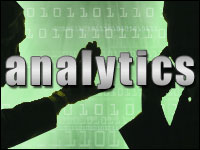
About ten years ago, I wrote a paper that predicted that analytics and social media would converge in CRM.
I believed that for two reasons. First, I believed social media was inevitable, though I had no idea what form it would take. Facebook was not on my radar and had not officially launched, MySpace was something for kids, and Twitter had definitely not been invented yet.
Plaxo and LinkedIn, however, offered tantalizing glimpses of what was possible in business with social networking. I believed something of that ilk would eventually drive CRM.
My second insight was that those social media applications would, out of necessity, churn up a lot of data that would be useless unless we pushed it through an analyzer. However, if we did that pushing, valuable stuff would come out of the other end of the data pipe.
What amazed me then, and continues to amaze me, is the rate at which knowledge is doubling, thanks to all that data dug up by social media.
Twice the Knowledge in Half the Time
In 1982, Buckminster Fuller — futurist, architect, some would say crank — published “Critical Path.” His book estimated knowledge doubling like this: Take all human knowledge up to the beginning of the Christian Era and call it one unit. It took 1500 years for that knowledge to double. Knowledge doubled again by 1750 — the beginning of the Industrial Revolution — and again by 1900.
Today, knowledge is doubling at a rate of between one to two years. IBM predicts doubling time will be down to 11 hours by 2014.
All that knowledge generation will have a lot of impact. Its most important lesson, from my perspective, is that those who don’t learn how to manage Big Data and the information it generates in our own businesses will be toast.
Another lesson: Our ability to generate new knowledge is so prodigious that it will become increasingly difficult to generate knowledge that is unique to any person or business.
We generate so much data today that it is possible by induction and other processes to infer knowledge that others might have and might think is proprietary. On the other hand, failing at analysis will leave much information hidden in a morass of raw data.
This all points to the need and even urgency attached to developing strategies for dealing with Big Data.
Subscribing to Subscriptions
Last week at SugarCon 2013 in New York, I gave a talk on one of my favorite topics, the subscription economy. I quoted some research from Gartner: By 2015 35 percent of the Fortune 2000 would derive some of their revenue from subscriptions.
There was this data point from Aberdeen: Only about 20 percent of companies studied had subscription businesses that appeared viable in that they had high customer satisfaction and renewals. Their new contract value (NCV) was a positive number.
While Gartner might be right in its prognostication, it leaves much unsaid because revenue is not profit. Even a bad subscription company can generate revenue while it’s going out of existence because it loses money on every transaction.
How then does a company become part of that top quintile?
Simple. It develops metrics that it derives from customer data about use, payments and sentiment, and relentlessly pursues them — all with the goal of optimizing customer experience and involvement.
Needless to say, metrics are made possible by analytics, both the reporting kind and the predictive data modeling kind.
Big Data Vs. What We Do With It
There’s a boom happening in the analytics business these days with companies like GoodData, Totango and Gainsight among many others. I think smart companies — subscription or otherwise — ought to pay attention.
That was my simple message at SugarCon. The not-so-simple reality, however, is that most companies are not on the bandwagon yet. They still don’t know what to do about Big Data, and they aren’t exhibiting the needed curiosity to figure out that it’s time to get on track with subscriptions and analytics.
Another finding that comes to me from long practical experience: While knowledge might be doubling quickly, our ability to apply it lags. I expect that a metric of new knowledge vs. applied knowledge would show a widening gap between what we know and what we do with it.
Very soon I will publish an ebook of interviews with five CMO’s of some fast-growing companies. What’s interesting about each of them is how these marketers have embraced Big Data, and have come up with strategies and metrics that better enable them to understand their businesses.
They know that the knowledge-doubling that we are all caught up in isn’t some abstract concept. It affects them — and it represents one of the great opportunities of this new century.





















































